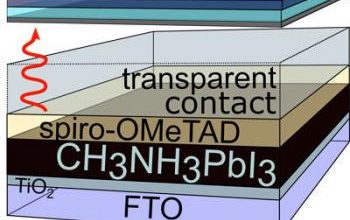Graphene as a front contact for silicon-perovskite tandem solar cells
World’s first 2D sheets of organic-inorganic hybrid perovskites grown from a solution
Researchers at the Helmholtz-Zentrum Berlin (HZB) developed a process for coating perovskite layers with graphene for the first time, so that the graphene acts as a front contact.
A traditional silicon absorber converts the red portion of the solar spectrum very effectively into electrical energy, whereas the blue portions are partially lost as heat. To reduce this loss, the silicon cell can be combined with an additional solar cell that primarily converts the blue portions and a particularly effective complement to conventional silicon is perovskite. However, it is normally very difficult to provide the perovskite layer with a transparent front contact. While sputter deposition of indium tin oxide (ITO) is common practice for inorganic silicon solar cells, this technique destroys the organic components of a perovskite cell.
The HZB scientists have found an innovative solution to that problem, in a process that covers the perovskite layer evenly with graphene – forming an extremely thin film that is highly conductive and highly transparent. For that to happen, the researchers first promoted growth of the graphene onto copper foil from a methane atmosphere at about 1000 degrees Celsius. For the subsequent steps, they stabilise the fragile layer with a polymer that protects the graphene from cracking. In the following step, they etch away the copper foil. This enables the transfer of the protected graphene film onto the perovskite. This is normally carried out in water, where the graphene film floats on the surface and is “fished out” by the solar cell. However, in this case this technique does not work, because the performance of the perovskite degrades with moisture. Therefore it was necessary to find another liquid that does not attack perovskite.
Tests proved that the graphene layer acts as an ideal front contact in several respects. Thanks to its high transparency, none of the sunlighté¥æª energy is lost in this layer. But the main advantage is that there are no open-circuit voltage losses, that are commonly observed for sputtered ITO layers. This increases the overall conversion efficiency. The solution is also comparatively simple and inexpensive to implement. The success in implementing graphene in a perovskite solar cell for the first time enabled the scientists to build a high-efficiency tandem device.
Helmholtz BerlinPerovskite applicationsPerovskite SolarHybrids and related materialsEfficiency
Above are Graphene as a front contact for silicon-perovskite tandem solar cells web publication,Hope can help you.
Perovskite solar cells may recharge electric cars’ batteries




